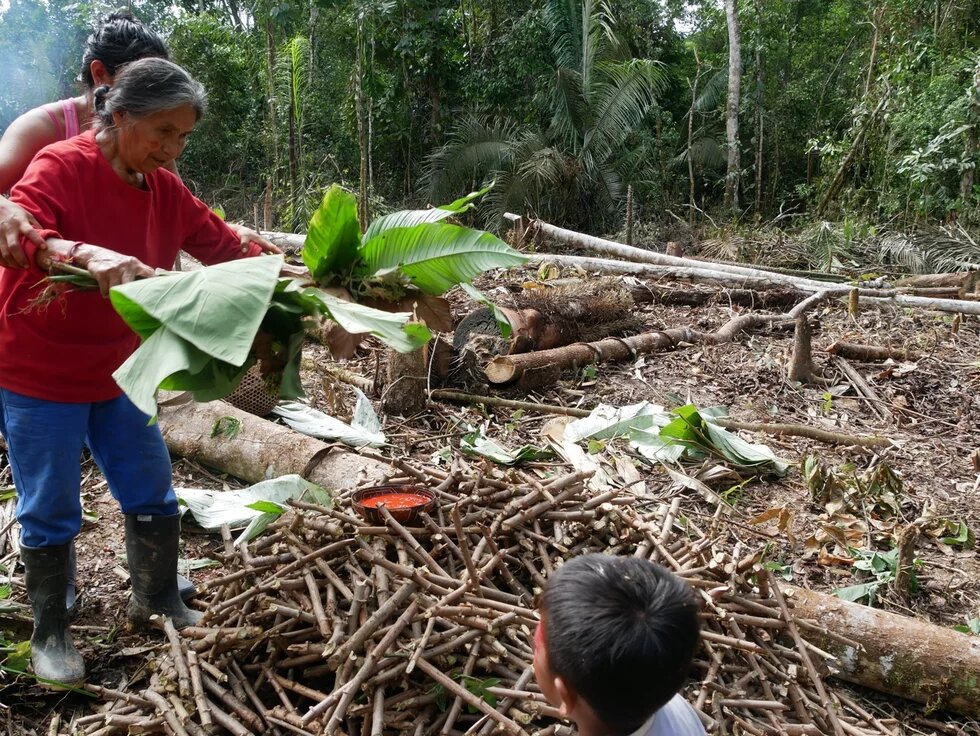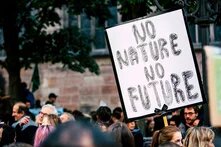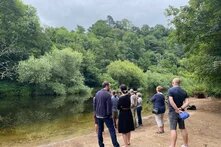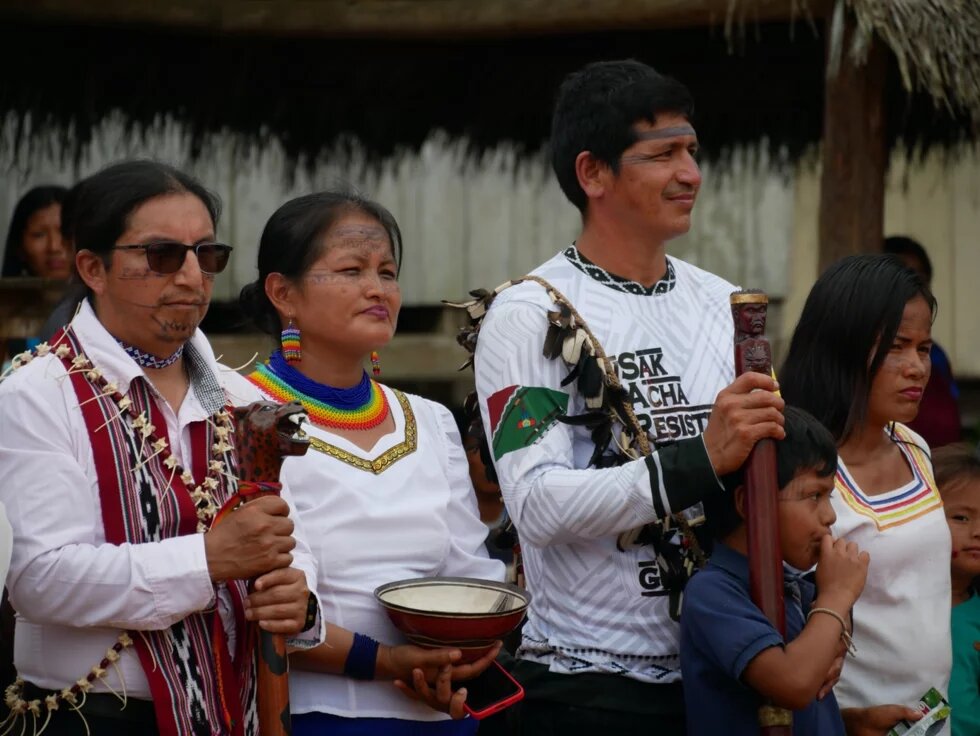
The Rights of Nature require an intercultural dialogue between different perspectives on nature. Indigenous Peoples are undertaking numerous efforts to bring the concept to life. The underpinning world views and organisational structures often differ fundamentally from those the respective state’s legal system is based on.
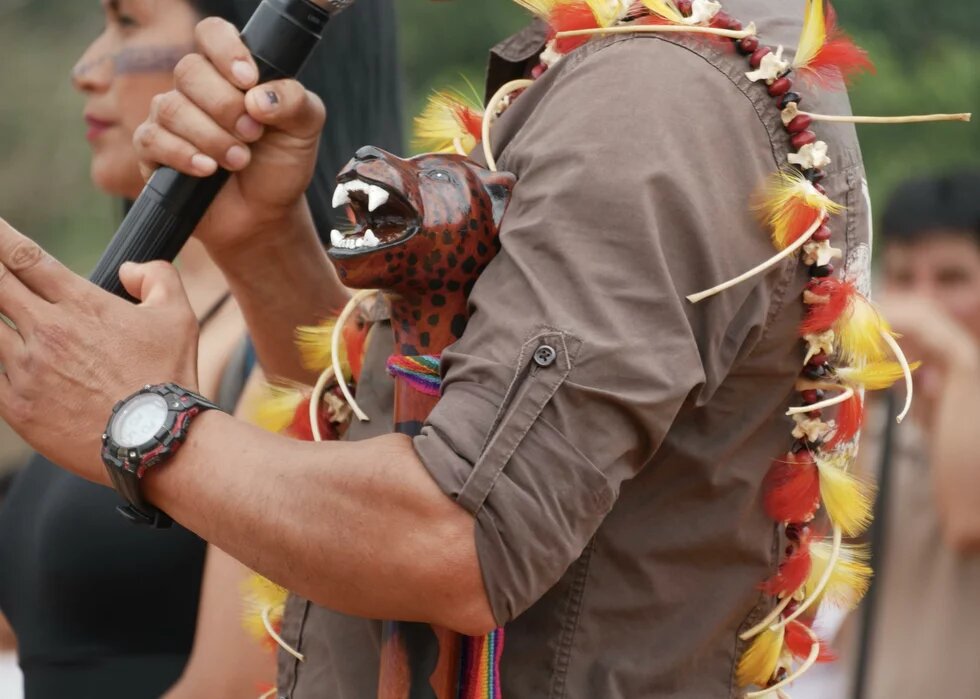
The proposal of the Pueblo Originario Kichwa de Sarayaku (Indigenous Kichwa People of of Sarayaku) is particularly resonating and far-reaching. They propose that their territory in the Ecuadorian Amazon region be recognised as ‘Kawsak Sacha’ (Living Forest) using the language of Rights of Nature – as ‘a living and conscious being that is the bearer of rights’. Sarayaku has its own administrative structures and forms and senses of justice. Such autonomy of Indigenous Peoples and Nations is constitutionally recognised by the Ecuadorian state.
The Declaration of the Living Forest (Kawsak Sacha)
Sarayaku’s proposal is primarily intended to counter the exploitation of nature through extractivism and other forms of depletion. However, it is also about resignifying the concept of the Living Forest and establishing rules for people’s interaction and conviviality with the forest.
The Living Forest is legally recognised through the Declaratoria de la Selva Viviente (‘Declaration of the Living Forest’), which was drafted in a collective creative endeavour by the People of Sarayaku. The drafting of the Declaration can be interpretated as what I term a legal minga. Minga is a form of collective labour originating from an Andean and Amazon context, often involving an entire village performing vital community tasks (i.e. building paths, or cultivating manioc (Manihot esculenta). A minga for cultivating manioc illustrates a respect for life cycles and the maniocs’ own laws.
Within the framework of this legal minga, a form of what I call Living Forest Constitutionalism was developed, which includes the ‘Declaration of the Living Forest’ and other provisions, including the so-called ‘Norms of Conviviality’, containing rules on hunting and fishing. A legal minga as well involves collective reflections of these legal instruments during assemblies and sharing points of view or corazonares (heartfelt thinking).
Such as Hilda Santi, a Sarayaku lidereza (leader), shared:
‘We are using the language of the state and of law in the Declaration to assert the rights we have under the Ecuadorian Constitution: (collective rights and the Rights of Nature).’
At the same time, the Living Forest itself can be interpreted as source of law (García Ruales 2024). Recognising the forest as such means acknowledging the Living Forest as a normative network and the normativity of intrinsic autopoietic processes. It includes rules concerning the behaviour of humans and all other beings dwelling in the forest. Article 3 of the Declaration sketches out a forest pluriverse consisting of six different worlds: the mineral, animal, vegetal, cosmic, spiritual and human worlds. Through cohabitation with all entities in the forest, the Sarayaku learn how humans can coexist with the forest.
Kuraka Yashinku, a legal guardian who belongs to different worlds, is organising and protecting the monkeys. Kuraka Yashinku is a leader, responsible for co-governance (co-gobernanza). As Narciza Gualinga shared with me, he has provided guidance on how many monkeys should be hunted. Kuraka can be translated as ‘traditional authority’. Animals, plants, supays (cosmic beings) have their own Kurakas: in these narratives, beings of the forest themselves are lawmakers. Thus, for instance, organisational structures in Sarayaku were inspired by animals.
When the legal minga was conducted to create the ‘Declaration of the Living Forest’, it was impossible to name all the beings belonging to the forest cosmos. Only the most prominent ones, such as Amazanga, “the most respected by all. Beings of the Forest” or Nunkuli, the feminine power were explicitly named in the Declaration. The intercultural dialogue Sarayaku wishes to continue through the ‘Declaration of the Living Forest’ is twofold: On the one hand, the forest with all its inhabitants represents a cosmos characterised by a complexity of rules, which is translated into written words and thus made accessible to the people of Sarayaku. The Declaration is therefore not only to be interpreted as a Rights of Nature text, but extends beyond this:
It is also a proposal for coexistence in Sarayaku. It is intended to help respect and apply the rights of the forest to enable a ‘good life’.
On the other hand, the textuality of the written law materialised in the Declaration must also be comprehensible to people outside Sarayaku, thus to breathe life to an expression of the Rights of Nature. The Declaration lists a whole set of arguments for why the Living Forest should be a bearer of rights. It is a Sarayaku legal instrument, a category derived from Sarayaku forms of knowledge and drafted on paper in a written form to convey Living Forest Law.
Application of ‘Living Forest Law’
The concrete implementation of the Living Forest Declaration is – as is probably the case with any law – controversial and subject to continuous change. Sarayaku’s human population, for instance, is increasing, while wild animals and other forest entities are becoming fewer. As a result, ‘sufficient’ hunting is less feasible than before (and what is understood by ‘sufficient’ has also changed over time).
This affects hunting practices. Nowadays, Sarayaku’s human inhabitants have to venture deeper into the forest in order to hunt successfully. For this reason, practices called ‘hunting well’ have been introduced. They are based on various strategies, including dialogue with ‘external’ knowledge. Kaskirunas – guardians of the Living Forest who constantly monitor its state – now determine where chakras (areas of cultivation in traditional rotation systems) are to be located. Prohibitions apply to tapir hunting (Tapirus terrestris), the hunting of animals in herds or with young animals, or fishing with barbasco (Lonchocarpus utilis), a poisonous plant substance. In addition, Living Forest Law forbids the sale of game meat. Moreover, rules apply to how much hunting is allowed during traditional festivals, such as the Pacha Mama festival.
During this festival, Sarayaku celebrate Pacha Mama as an entity while commemorating the recognition of property titles of their land in 1992. This certainly had an influence on the overall recognition of the Rights of Nature in Ecuador, with a strong Indigenous movement being an important driving force.
During Pacha Mama festival, Sarayaku incorporates the Living Forest as a concept, constantly re-evaluating it and nurturing the concept with practices such as performances, dances, traditional competitions.
Each Runa (person from Sarayaku) has their own way of applying the law of the Living Forest, Kawsak Sacha. Everyone relates to the beings of the forest in their own way. Nevertheless, Sarayaku have developed strategies at a collective level to promote the Declaration and the struggle for the Living Forest. They took part in the Paris climate conference 2015, even bringing a humming-bird canoe (Kindy-Challwa), as well as in Bonn in 2017. In 2022, an Amazon climate conference (2022) took place on their territory (the Kawsari). Here, representatives of different Indigenous Peoples and Nations came together to share knowledge and take action together.
With the category of the Living Forest, Sarayaku is making a proposal for life on Earth for all Peoples of the world to be realised in a global minga. This proposal is based on the Rights of Nature, collective rights for Peoples and Nations, and the Living Forest itself, inviting the formulation of distinct legal instruments for a conviviality with nature.
After all, in the Amazon Living Forest, it is not only the calls of frogs like Unkulu that can be heard. We also find rain ants, sun ants and the toucan (Ramphastos tucanus) with their songs. The creatures of the forest are singing in the territory – and their songs are being recorded in the ‘Declaration of the Living Forest’. Their singing is an expression of their existence. This existence and this singing are protected in the Ecuadorian constitution, by the Rights of Nature.
This is the English version of an adapted German-language book chapter published in the 2023 edited volume Rechte für Flüsse, Berge und Wälder, edited by Matthias Kramm, Oekom (see below).
Translated from German by Imke Horstmannshoff.
Up-to-date developments on Rights of Nature cases can be found on the open-access platform EcoJurisprudence Monitor.
Links & Literature
- Pueblo Originario Kichwa de Sarayaku
- García Ruales, J., and A. Gutmann. “Rechte der Natur in Lateinamerika.” In Rechte für Flüsse, Berge und Wälder, edited by Matthias Kramm, München: Oekom Verlag, 2023, 28-48.
- García Ruales, J. (2024): “Forest moralities, Sacha Runakuna and kindred knowledge: Kawsak Sacha as a law.” The International Journal of Human Rights: 1-25.
- García Ruales, J., & Y. V. Gualinga (2024). “A Well-braided (Knowledge) Braid: Lessons learned from the Kawsak Sacha and the Forest Beings to Europe”. In Rights of Nature in Europe: Encounters and Visions, edited by J. García Ruales et al. London: Routledge: 27-44.
- Jenny García Ruales, Luis Eslava and Viviana Morales Naranjo (2025). "Legal "Heartfelt Thinking!: How "Mingas" Help Evolving the Law." Verfassungsblog, 2024.
- Matthias Kramm (Hg., 2023). Rechte für Flüsse, Berge und Wälder. München: Oekom Verlag.

